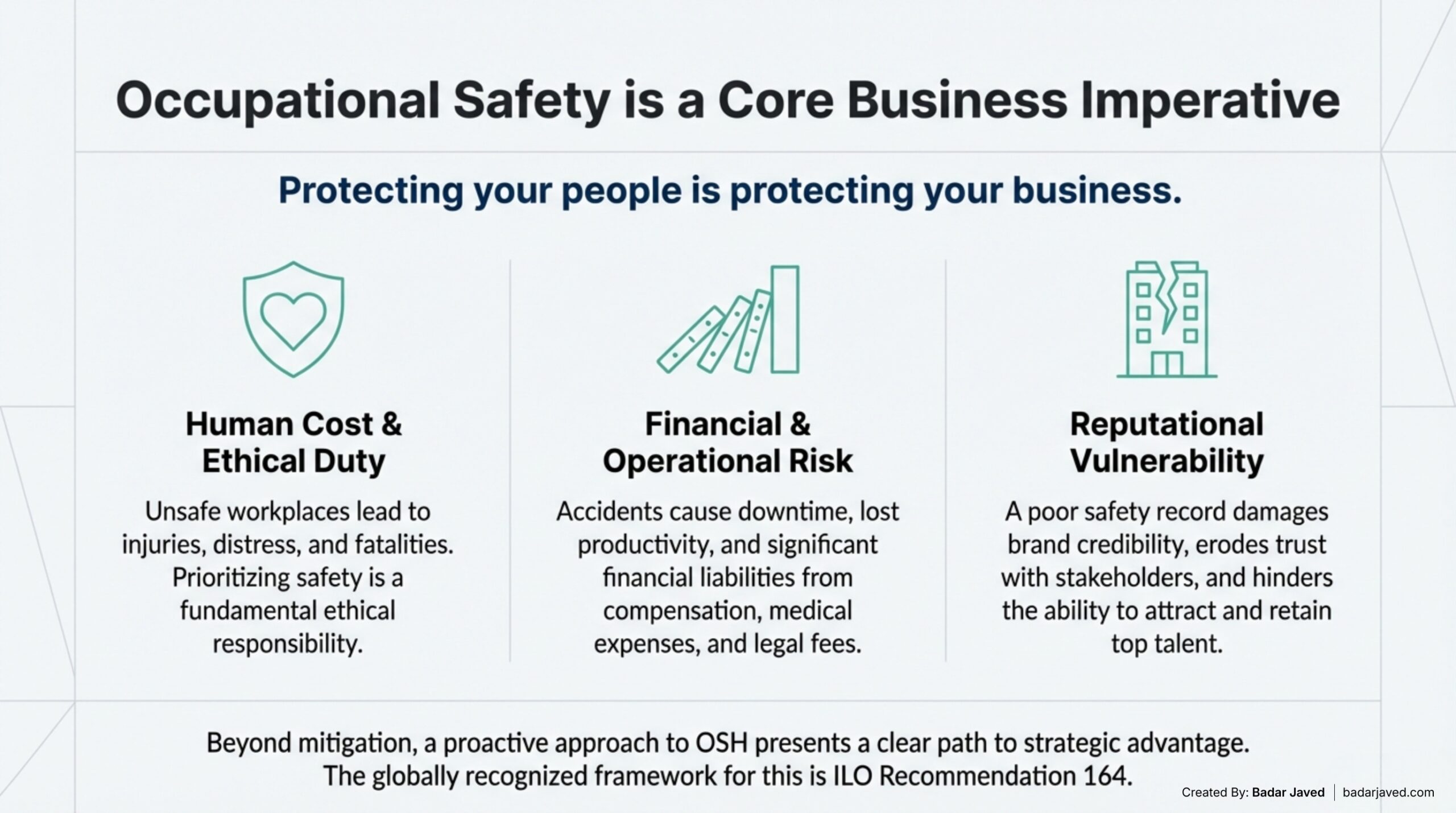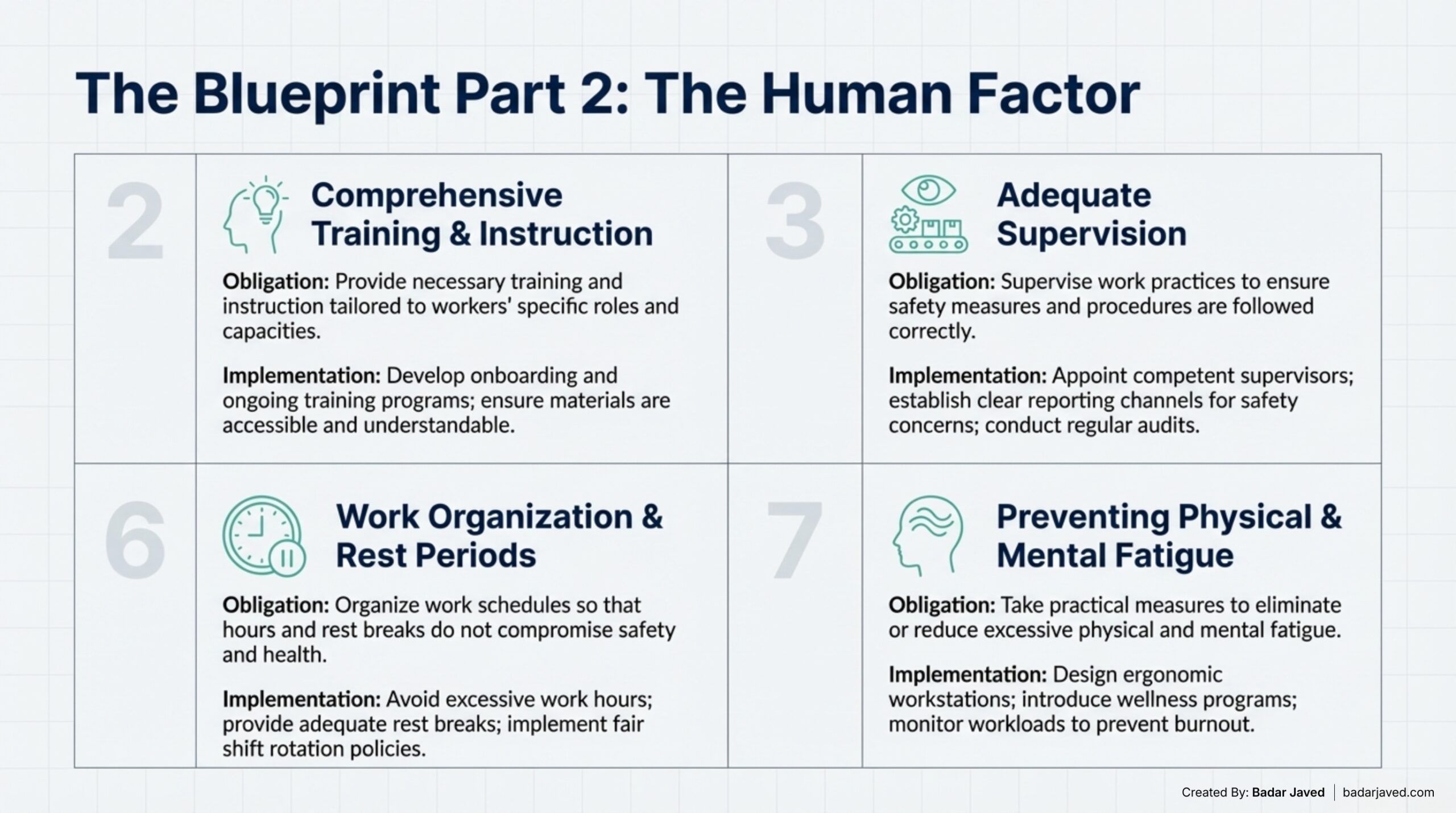Ensuring the safety and health of workers is a fundamental responsibility of employers, enshrined in various international labor standards. One such critical framework is Recommendation 10 of ILO R164 – Occupational Safety and Health (OSH) Recommendation, 1981, which outlines obligations for employers to maintain a safe and healthy working environment. These obligations are essential for mitigating workplace risks and fostering a safety culture.
This article delves into the key employer responsibilities under this recommendation, offering actionable insights and practical takeaways.


Overview of ILO Recommendation 164
Adopted by the International Labour Organization (ILO), Recommendation 164 complements the Occupational Safety and Health Convention, 1981 (No. 155). While the Convention sets the legal framework, Recommendation 164 provides detailed guidance for implementing occupational safety and health measures tailored to diverse industries and work environments.
At its core, Recommendation 10 emphasizes proactive measures to protect workers from occupational hazards, ensuring their physical and mental well-being. Below are the principal obligations placed upon employers.

Employer Obligations Under Recommendation 10
Recommendation 10 of the ILO R164 outlines specific obligations employers should fulfill to achieve the objectives of Article 16 of the Occupational Safety and Health (OSH) Convention, 1981 (No. 155). These obligations aim to safeguard the health and safety of workers across various sectors by establishing clear responsibilities tailored to different work environments and industries. Below is a detailed explanation of these obligations:
1. Safe Workplaces and Equipment
Employers are required to:
- Provide and maintain safe workplaces to minimize hazards and risks.
- Ensure that the workplace’s machinery, equipment, and tools are safe and compliant with applicable safety standards.
- Adopt work methods that are as safe as reasonably practicable to prevent workplace accidents and health risks.
Implementation:
- Conduct regular inspections and maintenance of machinery and tools to ensure they function safely.
- Replace outdated equipment and adhere to the latest safety regulations.
- Establish protocols for hazardous tasks, ensuring that risks are mitigated effectively.

2. Comprehensive Training and Instruction
Employers must provide necessary training and instructions tailored to workers’ specific roles and capacities.
Implementation:
- Develop training programs for new employees, including safety orientation.
- Provide ongoing training for current workers, especially when new equipment or work methods are introduced.
- Ensure training materials are understandable and accessible to workers of varying education levels and languages.
Example:
Training on handling hazardous materials and using safety gear in a chemical plant is critical to preventing workplace incidents.
3. Adequate Supervision
Employers are responsible for supervising work practices and ensuring that safety measures and procedures are followed correctly.
Implementation:
- Appoint competent supervisors to monitor adherence to safety protocols.
- Establish clear reporting structures for workers to communicate safety concerns.
- Conduct regular audits and safety checks to ensure compliance.
4. Organizational Arrangements
Employers must implement organizational systems and structures for managing occupational safety and health proportionate to the size and nature of the business.
Implementation:
- Create a dedicated occupational safety and health department or appoint a safety officer in smaller organizations.
- Form safety committees to oversee and evaluate safety measures.
- Develop clear documentation, such as safety manuals and emergency response plans.
Example:
A construction company might establish a safety management system with roles defined for hazard identification, worker training, and emergency preparedness.

5. Provision of Personal Protective Equipment (PPE)
Employers must provide adequate PPE to workers at no cost, especially when hazards cannot be eliminated or controlled through other means.
Implementation:
- Identify job roles and tasks requiring PPE, such as helmets, gloves, goggles, or respiratory masks.
- Ensure that PPE is suitable for the specific hazards and is properly maintained.
- Train workers on the correct use and care of PPE.
6. Work Organization and Rest Periods
Work schedules must be organized to ensure that hours of work and rest breaks do not compromise occupational safety and health.
Implementation:
- Avoid excessive work hours that lead to fatigue.
- Provide adequate rest breaks, especially during physically demanding or high-risk tasks.
- Implement shift rotation policies to distribute workloads evenly.
Example:
A delivery company should ensure drivers have adequate breaks to prevent fatigue, which could lead to accidents.
7. Preventing Physical and Mental Fatigue
Employers should take practical measures to eliminate or reduce excessive physical and mental fatigue among workers.
Implementation:
- Design ergonomic workstations to minimize strain and discomfort.
- Introduce wellness programs to address mental health concerns.
- Monitor workloads to prevent burnout and ensure tasks are distributed fairly.
Example:
Providing ergonomic chairs and encouraging regular breaks can help reduce physical strain and mental fatigue in an office setting.

8. Scientific Research and Knowledge Updates
Employers are encouraged to stay informed about the latest scientific and technical developments in occupational safety and health.
Implementation:
- Subscribe to updates from recognized safety organizations and research bodies.
- Conduct internal or external research to identify emerging risks.
- Use insights from studies to refine safety practices and adopt innovative solutions.
Example:
A manufacturing company might invest in new ventilation systems based on research about airborne hazards in enclosed environments.
Summary of Employer Responsibilities
Recommendation 10 emphasizes a proactive, comprehensive approach to occupational safety and health. Employers must:
- Ensure physical workplaces and equipment are as safe as possible.
- Provide training tailored to workers’ roles.
- Supervise the implementation of safety measures.
- Create and maintain organizational systems for safety management.
- Supply appropriate PPE at no cost to workers.
- Organize work schedules to prevent fatigue and promote safety.
- Address physical and mental fatigue through ergonomic and wellness measures.
- Stay updated on advancements in occupational safety to maintain compliance and effectiveness.
By meeting these obligations, employers comply with international standards and demonstrate a commitment to worker well-being and operational excellence.
Why Adhering to Recommendation 10 Matters
Adhering to Recommendation 10 of ILO R164 is vital for employers for several reasons, ranging from safeguarding employee well-being to enhancing operational efficiency and legal compliance. This recommendation provides a detailed framework to ensure occupational safety and health (OSH), which is integral to fostering a safe, productive, and sustainable work environment. Here’s an in-depth explanation of why compliance matters:

1. Ensures Employee Safety and Well-Being
Key Benefit: Protecting workers from injuries, illnesses, and fatalities.
- Unsafe working conditions can lead to accidents, which may result in physical harm, mental distress, or even fatalities.
- Ensuring safety through measures such as providing personal protective equipment (PPE), training, and supervision helps create a secure work environment.
Why It Matters: When workers feel safe, they experience reduced stress, increased job satisfaction, and improved morale, contributing to a healthier and more motivated workforce.
2. Promotes Compliance with Legal and Ethical Standards
Key Benefit: Avoids legal repercussions and demonstrates ethical responsibility.
- Adhering to international labor standards like Recommendation 10 shows that an organization respects workers’ rights and values their well-being.
- Many national regulations align with ILO guidelines, and compliance ensures that employers meet legal requirements and avoid penalties.
Why It Matters: Non-compliance can result in fines, lawsuits, and reputational damage, whereas compliance builds credibility and trust among stakeholders.

3. Enhances Operational Efficiency
Key Benefit: Reduces workplace disruptions caused by accidents or unsafe practices.
- Implementing safety measures minimizes the risk of incidents that can lead to downtime, lost productivity, and resource wastage.
- Proper training and safe equipment also improve task execution efficiency.
Why It Matters: Safe and efficient operations reduce costs associated with workplace injuries, absenteeism, and turnover, boosting overall productivity and profitability.

4. Fosters a Culture of Trust and Accountability
Key Benefit: Strengthens employer-employee relationships.
- Workers are more likely to trust employers who prioritize their safety and health.
- A robust safety culture encourages employees to report hazards, adhere to protocols, and actively participate in safety initiatives.
Why It Matters: This culture of trust leads to higher employee engagement, better teamwork, and a proactive approach to safety across the organization.

5. Builds a Positive Reputation
Key Benefit: Attracts and retains talent while enhancing market credibility.
- Companies that are committed to workplace safety are more attractive to potential employees, customers, and investors.
- A strong safety record demonstrates corporate responsibility and can be a unique selling point in competitive industries.
Why It Matters: A positive reputation can lead to increased business opportunities, stronger partnerships, and a loyal workforce.
6. Reduces Costs Associated with Workplace Incidents
Key Benefit: Saves money on compensation, medical expenses, and legal fees.
- Workplace accidents and occupational illnesses can result in significant financial liabilities.
- Proactive safety measures, such as routine maintenance and proper training, prevent costly incidents.
Why It Matters: Investing in preventive measures is far more cost-effective than dealing with the aftermath of accidents or injuries.
7. Improves Risk Management
Key Benefit: Prepares organizations to identify and mitigate potential hazards.
- By staying updated on the latest safety practices and conducting regular risk assessments, employers can anticipate and address potential risks before they escalate.
- Emergency preparedness ensures a quick and effective response to unforeseen incidents.
Why It Matters: Better risk management protects employees and assets, ensuring business continuity even in challenging situations.
8. Aligns with Global Sustainability Goals
Key Benefit: Contributes to sustainable development by prioritizing human and environmental well-being.
- Safe workplaces are integral to achieving broader sustainability objectives, such as the United Nations’ Sustainable Development Goal 8 (Decent Work and Economic Growth).
- Employers who implement Recommendation 10 contribute to ethical and responsible business practices on a global scale.
Why It Matters: This alignment demonstrates a commitment to long-term goals, benefiting both the organization and society.

9. Encourages Continuous Improvement
Key Benefit: Drives innovation and adaptability in workplace safety.
- Adhering to Recommendation 10 requires employers to stay updated on scientific and technological advancements in OSH.
- This ongoing effort fosters innovation in safety practices, tools, and technologies.
Why It Matters: Continuous improvement ensures that safety measures remain effective and adaptable to evolving work environments and risks.
10. Supports Organizational Growth
Key Benefit: Provides a strong foundation for sustained success.
- Safe workplaces attract talent, retain experienced employees, and improve overall productivity, creating a stable platform for growth.
- Demonstrating a commitment to safety helps organizations expand into new markets and industries by building trust with regulatory bodies and partners.
Why It Matters: Organizations prioritizing safety are better positioned to thrive in competitive and regulated environments.
Adhering to Recommendation 10 of ILO R164 is more than a regulatory requirement—it’s an investment in an organization’s future and its people. By safeguarding workers’ safety and health, employers create a positive work environment that fosters trust, efficiency, and growth. This commitment leads to long-term benefits, including reduced risks, enhanced reputation, and sustained success in an increasingly safety-conscious world.
Organizations that embrace these principles will comply with international standards and set themselves apart as leaders in workplace safety and health.

Conclusion: Building a Safer Workplace
Employers play a pivotal role in creating a safe and healthy working environment. By adhering to the obligations outlined in Recommendation 10 of ILO R164, they comply with international standards, foster trust, improve worker morale, and ensure long-term sustainability.
Investing in workplace safety is more than a regulatory requirement—it’s a commitment to protecting an organization’s most valuable asset: its people. Employers should continually strive to meet and exceed these guidelines to achieve excellence in occupational safety and health.

